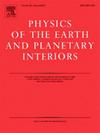Radial structure of the Earth: (II) Model features and interpretations
IF 1.9
3区 地球科学
Q2 GEOCHEMISTRY & GEOPHYSICS
引用次数: 0
Abstract
A new reference model is presented for the spherically-averaged profiles of elasticity, density and attenuation, which reflect the bulk composition, temperature profile and dominant processes of the Earth's heterogeneous interior. This study discusses the features of REM1D and geological interpretations while the underlying modeling concepts and reference datasets are described in a companion manuscript. All physical parameters in REM1D vary smoothly between the Mohorovičić and 410-km discontinuity, thereby excluding the 220-km discontinuity in earlier models. REM1D predicts arrival times of major body-wave phases in agreement (±0.8 s, normalized misfit 0.25 s) with widely used but theoretically incomplete isotropic models optimized for earthquake location. Substantial radial anisotropy is present only in the shallowest mantle (∼250 km) with peak values of shear-wave (aS = 3.90 %, = 1.08) and compressional-wave anisotropy (aP = 3.78 %, = 0.93) between ∼125–150 km, consistent with textures that can form by the alignment of intrinsically anisotropic minerals in this deforming region. The upper mantle (24.4–410 km) is the most dissipative region with a finite bulk attenuation ( 386) and strong shear attenuation ( 60–80) that peaks at a depth of ∼150–175 km in the mechanically weak asthenosphere. An olivine-rich pyrolitic composition is broadly consistent with REM1D structure in the upper mantle and extended transition zone ( 800 km) with step changes across the 410-km and 650-km discontinuities. Features of the lower mantle can be reconciled with: (i) effects of thermally driven convection throughout the central lower mantle (771–2741 km) leading to an apparent subadiabaticity in the stratification parameter , (ii) effects of spin transitions in iron-bearing minerals that manifest as distinct linear segments in modulus and Poisson's ratios (, ) on either side of a complex transition region (∼1300–1700 km, 52–73 GPa), (iii) a thermal boundary layer with steeper superadiabatic gradients than near the surface, which ultimately exceed the critical gradients for both and (but not for density ) at a depth of 2741 km, and (iv) chemical stratification in the bottom ∼500–750 km of the mantle that acts to suppress the thermal effects. Signatures of this thermo-chemical boundary layer are: (i) a gradual increase of density and steep positive gradients with depth in the lower mantle, (ii) large values of the stratification parameter ( 1.03) followed by an abrupt reduction to values below one near the core-mantle boundary (CMB), (iii) variations in bulk modulus with pressure = / that are inconsistent with Equations of state (EoS) expectations of a uniform composition, (iv) very steep negative and gradients that form a low-velocity zone in the region. The and variations in the outer core have steep gradients and the derivative properties are consistent with a neutrally stable region comprising a well-mixed iron alloy undergoing adiabatic compression ( 1, 0, negative ). REM1D is readily extendable due to its modular construction and represents the average physical properties, features essential for geological interpretations and the construction of a three-dimensional reference Earth model.

地球的径向结构:(II)模式特征和解释
提出了一种反映地球非均质内部体积组成、温度分布和主要过程的弹性、密度和衰减球平均剖面的新参考模型。本研究讨论了REM1D和地质解释的特征,而潜在的建模概念和参考数据集在一份配套手稿中进行了描述。REM1D的所有物理参数在mohorovi和410 km不连续面之间平滑变化,从而排除了早期模型中的220 km不连续面。REM1D预测的主要体波相到达时间与广泛使用但理论上不完整的地震定位优化各向同性模型一致(±0.8 s,归一化失拟合ψpb≤0.25 s)。大量的径向各向异性仅存在于最浅的地幔(~ 250 km),剪切波(aS = 3.90%, ξ = 1.08)和压缩波各向异性(aP = 3.78%, ϕ = 0.93)的峰值在~ 125-150 km之间,这与该变形区域内在各向异性矿物排列形成的结构一致。上地幔(24.4 ~ 410 km)是最耗散的区域,具有有限的体积衰减(Qκ ~ 386)和强剪切衰减(Qμ ~ 60 ~ 80),在机械弱软流层中达到峰值,深度为~ 150 ~ 175 km。富含橄榄石的火成岩组成与上地幔的REM1D结构和扩展过渡带(> 800 km)大致一致,在410 km和650 km不连续上呈阶梯变化。下地幔的特征与:(i)整个下地幔中央(771-2741 km)的热驱动对流效应导致分层参数ηB出现明显的亚绝热;(ii)在复杂过渡区(~ 1300-1700 km, 52-73 GPa)两侧,含铁矿物的自旋转变效应在模量和泊松比(μ/κ, σP)上表现为明显的线性段;(iii)热边界层的超绝热梯度比地表更陡。最终在2741 km的深度超过了vP和vS的临界梯度(但没有密度ρ),以及(iv)地幔底部~ 500-750 km的化学分层抑制了热效应。该热化学边界层的特征是:(1)下地幔密度随深度dp /dz逐渐增大,且呈陡峭的正梯度;(2)分层参数η >值较大;1.03),随后在核心-地幔边界(CMB)附近突然降至1以下,(iii)体积模量随压力κ ' = dκ/dp的变化与均匀组成的状态方程(EoS)期望不一致,(iv)非常陡峭的负vP和负vS梯度在D″区域形成了一个低速带。外核vP和ρ的变化具有陡峭的梯度,导数性质符合由混合良好的铁合金组成的中性稳定区(ηB≃1,N2≃0,负κ″)。REM1D由于其模块化结构而易于扩展,并且代表了地质解释和三维参考地球模型构建所需的平均物理性质、特征。
本文章由计算机程序翻译,如有差异,请以英文原文为准。
求助全文
约1分钟内获得全文
求助全文
来源期刊

Physics of the Earth and Planetary Interiors
地学天文-地球化学与地球物理
CiteScore
5.00
自引率
4.30%
发文量
78
审稿时长
18.5 weeks
期刊介绍:
Launched in 1968 to fill the need for an international journal in the field of planetary physics, geodesy and geophysics, Physics of the Earth and Planetary Interiors has now grown to become important reading matter for all geophysicists. It is the only journal to be entirely devoted to the physical and chemical processes of planetary interiors.
Original research papers, review articles, short communications and book reviews are all published on a regular basis; and from time to time special issues of the journal are devoted to the publication of the proceedings of symposia and congresses which the editors feel will be of particular interest to the reader.
 求助内容:
求助内容: 应助结果提醒方式:
应助结果提醒方式:


